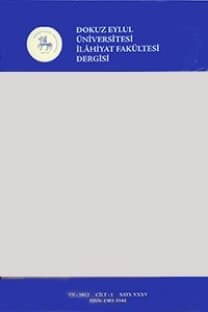TEFSÎRDE KİTAB-I MUKADDESİN TAHRÎFİ MESELESİ: II (Tahrîf Kelimesinin Müradifleri Bağlamında)
THE ISSUE OF CORRUPTION OF HOLY BOOKS IN TAFSEER: II (In the Context of Synonyms and Ways of the Word of Corruption)
Exegesis, corruption, problem, text, meaning,
___
- İsfehânî, İsfehânî, Ragıb, Müfredât, Safvân Adnan, Dâru’l-kalem-ed-Dâru’ş-şamiyye, Dımeşk-Beyrut 1412.
- Makrîzî, Ahmed b. Ali, Hıtat el-Makrîzî, y.y. Kahire 1270.
- Mâtürîdî, Ebû Mansur, Te’vîlâtü ehli’s-sünne, Müessesetü’r-risâle, Beyrut 2004.
- Muhammed Abdüh- Reşid Rızâ, Tefsîru’l-menâr, Dâru’l-ma‘rife, Beyrut ts.
- Râzî, Fahruddîn, Mefâtîhu’l-ğayb, Dâru ihyâi’l-türâsi’l-Arabî, Beyrut 1420.
- Taberî, Câmiü’l-beyân, Müessesetü’r-risâle, Beyrut 2000.
- Tarakçı, Muhammed, “Tevrât ve İncîl’in Tahrîfi ile İlgili Kur’ân Âyetlerinin Anlaşılması Sorunu” Usûl Dergisi, sy. 2, Adapazarı, 2004.
- Yavuz, Salih Sabri-Yeniçağ, İbrahim, “Müslüman-Hıristiyan Polemiği Açısından Tahrîf”, Milel ve Nihal, cilt 6/sy 1, y. y. Nisan 2006.
- Yıldırım, Arif, “Kelamî Açıdan Tevrât ve İncîlde Tahrîf Meselesi”, Atatürk Üniversitesi İlahiyat Fakültesi Dergisi, sy. 26, Erzurum 2006.
- Zemahşerî, Ebû Kasım Mahmûd b. Ömer, el-Keşşâf an hakâik ğavâmidi’t-tenzîl ve’l-uyûni’l-avâni’l fî vücûhi’t-te’vîl, Dâru ihyâi’t-türâsi’l-Arabî, Beyrut 1997.
- ISSN: 1303-3344
- Yayın Aralığı: 2
- Başlangıç: 1983
- Yayıncı: Dokuz Eylül Üniversitesi İlahiyat Fakültesi
EBÛ HAYYÂN‟IN EL-BAHRU‟L-MUHÎT İSİMLİ TEFSİRİ BAĞLAMINDA NAHVE DAİR METODİK ESASLARI
FIKIH USULÜNÜN TEMELLERİ: HZ. PEYGAMBER DEVRİNDE DELİLLER
TEFSÎRDE KİTAB-I MUKADDESİN TAHRÎFİ MESELESİ: II (Tahrîf Kelimesinin Müradifleri Bağlamında)
ÜÇÜNCÜ YÜZYIL HIRİSTİYANLIĞINDA DİNDEN DÖNME HADİSELERİ VE NOVATİANİZM
Ebû Hayyân’ın el-Bahru’l-Muhît İsimli Tefsiri bağlamında Nahve Dair Metodik Esasları
ARAP DİLİNDE KÂNE [كَانَ] FİİLİ VE KUR’ÂN’DA KULLANIMI
MODERN SOSYOLOJİDE İİLEVSELCİLİK - EYLEMCİLİK TEORİLERİ İKİLİĞİNİ AŞMA ÇABALARI
